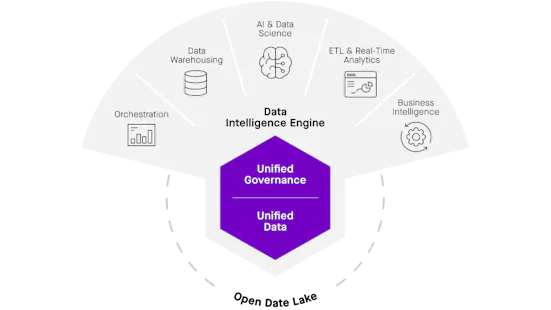
The modern data platform for analytics, AI and more:
Databricks
What does Databricks do?
At its core, Databricks offers a comprehensive ecosystem for data engineering, data science, business intelligence and real-time analyses - with Apache Spark as a high-performance cluster engine in the background. The data is managed in an open format (Delta Lake) in a structured manner - a principle that Microsoft Fabric has also adopted.
The 5 core functions of Databricks

Databricks combines many technologies on one platform. The most important building blocks:
- Business Intelligence & Dashboards
- Data Warehousing & Lakehouse Structures
- Data engineering & ETL orchestration
- Machine Learning & Advanced Analytics
- Real-time analytics & streaming
All functionalities are embedded in an open, scalable architecture with unified governance - including a central access control system via the Unity Catalog.
The difference: Why Databricks?
Traditional analytics processes often require time-consuming copying and restructuring of data in a central platform. Databricks breaks with this pattern:
- No redundant data storage: By using modern link technologies, data can be read directly from source systems such as SAP or Microsoft environments - without physical copies.
- Separation of compute and storage: Resources are only used where they are needed - this increases efficiency and reduces costs.
- Open architecture: Thanks to the support of open standards such as Delta Lake and Spark, Databricks can be flexibly integrated - even vendor-neutral.
Databricks, SAP and Microsoft Fabric in interaction
Databricks becomes particularly exciting when used in conjunction with other platforms:
- Databricks engines can be used in the SAP Business Data Cloud (BDC) without physically moving the data.
- There are also deep integrations with Microsoft Fabric - both platforms speak the same format (Delta), which enables seamless collaboration and analysis.
Conclusion: Databricks is not an island - but the bridge between different data worlds.
Why with All for One Analytics & Insights?
Our expertise:
Our experts have extensive experience with Databricks - both in Azure environments and vendor-independent. We are currently supporting projects in various industries and are constantly expanding our partnerships (e.g. as a registered Databricks partner).
10+ experienced consultants in Microsoft Fabric & Databricks projects:
Thanks to our vendor-neutral approach, we provide technology-neutral advice - regardless of whether your platform is SAP, Microsoft or another cloud solution.
